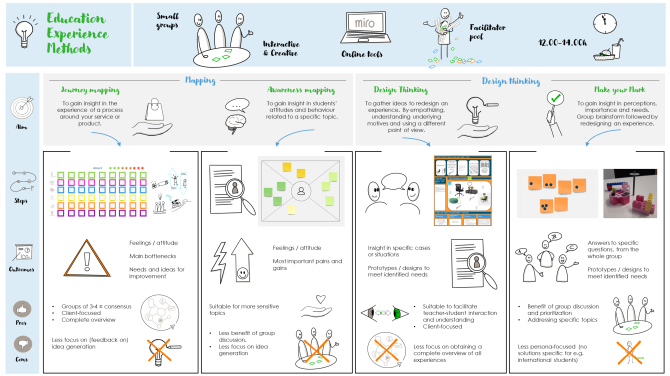
Methods of Education Experience
An education experience session comes in many forms. We specialise in the following methods: Customer Journey Mapping, Awareness Mapping, Design Thinking, and Make your Mark. We mostly host sessions on campus, but sometimes sessions are online. On this page, you can find more information about the methods that we use.
The education experience team started in 2018 with identifying the needs of students. Later on, we started identifying the needs of teachers and other education-related staff as well. We identify needs by organising sessions with our target group about specific topics (mostly) on campus. Over the years, new methods were added to our toolbox. Based on the questions asked by the team or department within WUR, we decide what methods should be used to best answer the questions of our clients.
We mostly organise sessions on-campus, but we sometimes host sessions online as well.
The Education Experience team used to host all its sessions on campus. These sessions were held during the lunch break, where a (vegetarian) lunch was served. Since March 2020 we had to transform our way of working to online completely. We tried many different tools, but have successfully worked with MS Teams in combination with the online whiteboard tool Miro. While we are very happy to host on-campus sessions again since March 2022, we have learned a lot from our online sessions. This is why sessions are occassionally still held online.
To give you an impression of our sessions, we use flipovers, post-it notes, lego and other materials during our sessions (image left and bottom right), making our sessions both fun and interactive. When sessions are online, we use the online whiteboard tool called Miro (image top right).
Our four different methods
We started of with (Customer) Journey Mapping for most of our sessions. After a while we noticed that not all questions asked by teams or departments within WUR could be answered through Journey Mapping. Therefore, we looked for other methods and expanded our toolbox to four methods (image below). These four methods help us to find the needs of students, teachers and other education- related staff.

Customer Journey Mapping
We use the customer journey map to gain insights into the process of the service or product by looking at the touchpoints, people, tools, emotions, needs and solutions.
Awareness Mapping
A way to gain insights in the attitudes and behaviours of the participants by putting focus on their past personal experiences. It goes over what you see, what you hear, what you think and feel, what you say and do, and the pains and gains you (as a participant) experienced.
Design Thinking
This method involves participants interviewing each other, identify a problem definition, ideate possible solutions, ask feedback, and come up with an end solution to the initial problem definition. The main value is that groups of participants work on each other's problems and think of solutions together.
Make your Mark
During the make your mark method we let participants individually think about and answer a few questions. Plenary we will discuss the answers that got the most votes. In duos the needs are identified whereafter the last steps of design thinking are used. Partcipants will ideate solutions based on the identified needs in the prior step.
Curious about the results of these methods?
If you would like to know what the results of the sessions are, or what the results that belong to a certain method are, please check out our Results page for a general overview.